
Cornell Central Campus
Encyclopedia
Central Campus is the primary academic and administrative section of Cornell University
's Ithaca, New York
campus. It is bounded by Libe Slope on the west, Fall Creek on the north, and Cascadilla Creek on the South.
donated his farm for the site of the Cornell University
as a part of the package to bring New York's land grant college to Ithaca. With the exception of Cascadilla Hall, no buildings were on the site so the campus evolved based on the hilly terrain and the conflicting visions of its designers, starting with Ezra Cornell and Andrew Dickson White
.
Over the years, the Buildings and Properties Committee of Cornell's Board of Trustees has maintained the stewardship of campus planning supported by a Vice President for Planning, Planning Office, and in recent years, a University Architect. Periodically, outside architects and consultants, beginning with Frederick Olmsted have been commissioned to develop master plans. Because the entire campus is subject to a special class of zoning, land use decisions are largely made internally rather than by the Ithaca zoning process. However, construction or renovation of statutory college
buildings are subject to additional planning steps involving the New York State University Construction Fund
Office.
In 2006-2007, Cornell embarked on another in its series of master plans, retaining Urban Strategies Inc. of Toronto as a consultant.
Historically, Cornell has been reluctant to demolish its buildings, but has repeatedly renovated and found new uses for old structures. Morrill Hall
is a National Historic Landmark. In 1971, Ithaca adopted a pioneering landmark and historic preservation ordinance, with the Arts Quadrangle and a number of individual buildings being designated landmarks or historic districts. Registered historic places on the central campus include: Andrew Dickson White House
, Bailey Hall, Caldwell Hall, old Comstock Hall
, Deke House, East Roberts Hall
(demolished), Fernow Hall, Rice Hall, Roberts Hall
(demolished) and Stone Hall
(demolished). The two Norwegian spurce trees in front of the Deke House planted by Theodore Roosevelt
are on the National Register of Historically Significant Trees. The campus includes more recent, 20th-century buildings that have earned architectural acclaim, especially the I. M. Pei-designed Johnson Art Museum and James Stirling
-designed Schwartz Performing Arts Center.
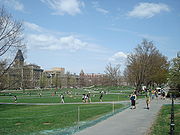
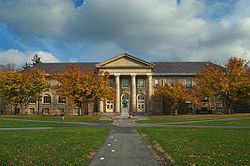
 The Arts Quad reflects Cornell and White's decision to use a quadrangle model for organizing academic buildings around formal open spaces. The quadrangle started with the "stone row" along the ridge of Libe Slope—Morrill (1866) and White (1867) Halls (both by Buffalo architects Wilcox and Porter), and McGraw (1869). Both McGraw and West Sibley
The Arts Quad reflects Cornell and White's decision to use a quadrangle model for organizing academic buildings around formal open spaces. The quadrangle started with the "stone row" along the ridge of Libe Slope—Morrill (1866) and White (1867) Halls (both by Buffalo architects Wilcox and Porter), and McGraw (1869). Both McGraw and West Sibley
(1870) Halls were designed by Syracuse architect Archimedes Russell. There were tensions between Cornell's preference for practical designs while White favored a more classical design. Hence although the Stone Row was built from native gray silt stone (nicknamed "llenroc"), later buildings including Lincoln Hall, Sage Residential College
and Sage Chapel
were built from red brick. Originally, the Arts Quadrangle was proposed to be a square extending to the east to the site of Baker Laboratory and Rockefeller Hall. However, the subsequent construction of Lincoln Hall and Goldwin Smith Hall ended up defining it as a rectangle, with its long dimension oriented North-South.
By 1871 Cornell had established one of the United States' early architecture schools, and many campus buildings built in the last quarter of the Nineteenth Century were designed by the architecture school's professors and students. Hence, Cornell's first architecture professor, Charles Babcock
, received many important commissions. Franklin
(1882; now Tjaden) and Lincoln
(1888) Halls reflect Babcock's interpretation of the Romanesque Revival style. William H. Miller
, who studied architecture under Cornell President Andrew D. White, also employed the Romanesque Revival
style in the design of Uris
Library (dedicated 1891), which has grown to iconically represent Cornell. Uris Library was expanded from its original cross shape twice—first to expand the library stacks and more recently to add underground reading rooms overlooking Libe Slope. Miller's Stimson Hall (1902), and the Sibley
Dome (1902), by Arthur N. Gibb (who also graduated from the Cornell architecture school), reflect Neoclassical themes. Cornell shifted to outside architects, the nationally prominent firm of Carrère and Hastings
, to design Goldwin Smith Hall (1904) and the adjacent Sheldon Memorial Exedra and Sundial (installed 1910), also in a Neoclassical style. Goldwin Smith Hall began as a modest building with an east-west orientation, but the 1904 expansion to its south converted it into the focal point of the east side of the Quad.
Next to Stimson Hall was Miller-designed Boardman Hall, constructed to house the Law School
in 1892, anchored the south end of the Quad until it was demolished in 1959.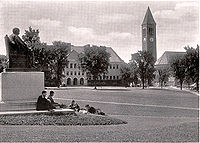 A central focus of the Arts Quad are statues of Cornell and White facing each other from the western and eastern edges of the quad. In 1959, Boardman Hall was demolished and replaced with the 240026 sq ft (22,299.1 m²) John M. Olin
A central focus of the Arts Quad are statues of Cornell and White facing each other from the western and eastern edges of the quad. In 1959, Boardman Hall was demolished and replaced with the 240026 sq ft (22,299.1 m²) John M. Olin
Graduate Library (1960) , designed by Warner, Burns, Toan & Lunde. The last addition to the Arts Quad is the Carl Kroch
Library, which opened on August 24, 1992. The building is underground between Stimson, Olin Library and Goldwin Smith Halls. A new wing for the Sidney Cox Library of Music and Dance was added to the rear of Lincoln Hall in 2000
To the west of White Hall is the Herbert F. Johnson Museum of Art
(1973) designed by I.M. Pei. The original design included an underground Asian art gallery which overlooked the gorge. However, this gallery was dropped due to funding. However, in response to a dramatic increase in the museum's collection, an altered version of that addition, totalling 16000 square feet (1,486.4 m²) is under construction to the north of the existing building. Previously, Morse Hall stood next to Franklin/Tjaden Hall, but it was destroyed by a fire.
Minor support buildings include Rand Hall (1911) designed by Gibb and Walts and the Foundry (1883). Finally, Milstein
Hall, a new 43000 square feet (3,994.8 m²) facility designed by Rem Koolhaas
will be built on the parking lot behind Sibley Hall. During 2007-2010, while Milstein Hall was pending, second year architecture students used rented studio space on Esty Street.
The landscaping of the Arts Quad is mostly informal and was historically dominated by towering elm trees. After Dutch elm disease
swept the campus, a new row of Zelcova trees was planted in the 1970s along the sidewalk on the eastern edge of the quad. These trees were selected for their vase shape (which are similar to elms trees), but unfortunately grow much slower than the elms which they replaced. The sidewalk on the northern edge is also significant because I.M. Pei aligned window slots in the Art Museum on the sidewalk's axis to preserve a view of West Hill through the museum.
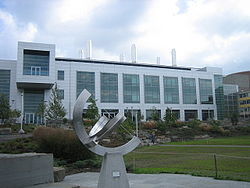 The Engineering Quad, was designed in the 1940s and 1950s on a site at the south end of the central campus previously occupied by the Old Armory and faculty housing, using a master plan developed by the Perkins and Will
The Engineering Quad, was designed in the 1940s and 1950s on a site at the south end of the central campus previously occupied by the Old Armory and faculty housing, using a master plan developed by the Perkins and Will
firm. It has undergone major changes in recent years, particularly with the completion of Duffield Hall. Prior to its construction, Engineering programs were housed in Lincoln Hall, Sibley Hall, Morse Hall and Franklin Hall at the north end of the Arts Quad. In 2004, relandscaping with a design inspired by Cascadilla Gorge was completed and its landmark sundial
(designed by Dale Corson) was restored to its rightful place on the quad (after having been stored in Upson Hall during the construction period). Also, modern and open collaborative working spaces were introduced with the construction of a large atrium
connecting Duffield, which houses research and teaching facilities for nanoscale science and engineering, with Phillips and Upson (1956) Halls. Connected to Upson Hall, away from the quad, are Grumman Hall (1957), which was built to house a Graduate School of Areospace Engineering, and Frank H.T. Rhodes Hall designed by Gwathmey
& Siegel (1990), which currently houses the Cornell Theory Center
. On the southern end of the Quad, next to Upson and near Cascadilla Creek, are Kimball, Thurston and Bard (1963) Halls, all part of a single brick and concrete structure. Thurston is the home to the Theoretical and Applied Mathematics department, and Bard Hall the home of the Material Sciences department. Between Upson and Kimball stands Ward Hall (1963), the soon to be closed down and former building for nuclear sciences. Next to Bard, and across the street from the Cornell Law School
, stand Snee Hall (1984), which houses the Geology Department, and Hollister Hall, (1957) which houses Civil Engineering. Carpenter Hall (1956), containing the Engineering Library, stands next to Hollister on the northwestern corner. The edge of northern face of the quad, mostly open space, is lined with trees along Campus Road. Across Campus Road is F.W. Olin
Hall (1941) the home of the Chemical Engineering department.
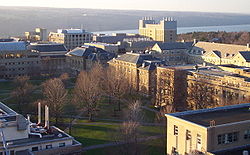 The Agriculture Quadrangle (Ag Quad) contains buildings which house many of the programs in the NYS College of Agriculture and Life Sciences
The Agriculture Quadrangle (Ag Quad) contains buildings which house many of the programs in the NYS College of Agriculture and Life Sciences
. It is a quadrangle
east of the Arts Quad and west of the College of Veterinary Medicine
. The oldest building still standing on the quad is Caldwell Hall, in the Colonial Revival style which opened in 1913. The Plant Science Building opened in 1931 and Warren Hall, across from Plant Science, opened in the next year, The art deco
style Mann Library on the eastern end of the quad, connecting Warren Hall on the north to the Plant Sciences Building on the south, opened in 1952. Between Plant Science and Tower Road is the greenhouses built in 1931 to house Liberty Hide Bailey's palm collection and the Minns Garden. Designed by Gwathmey
& Siegel and completed in 1990, Keith Kennedy and the "new" Roberts Halls, featuring an archway that connects the two halls, extend along the western face of the quad, having replaced the original Roberts Hall (1906) and East Roberts Hall and Stone
Hall. The Computing and Communications Center
(formerly named Comstock Hall), which was designed by Cornell faculty members, Clarence Martin, Jean Hebrard, and George Young, stands between Roberts and Caldwell Halls. The quad now opens toward the south with the Minns Garden between Roberts and Plant Science.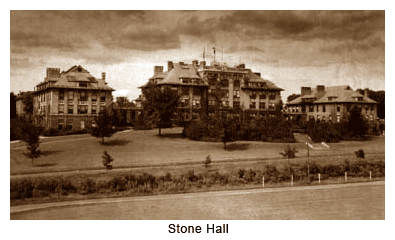 To the west of Roberts Hall is Bailey Hall (1912). It is the largest auditorium on the campus. Both Bailey Hall and "old" Comstock Hall are historic landmarks.
To the west of Roberts Hall is Bailey Hall (1912). It is the largest auditorium on the campus. Both Bailey Hall and "old" Comstock Hall are historic landmarks.
The most recent addition has been a 105372 sq ft (9,789.4 m²) expansion of Mann Library to the northeast, designed by Lee Timchula and opened in 2000.
programs have been housed in Martha Van Renssalaer Hall (MVR), a 171648 sq ft (15,946.6 m²) Georgian Revival style brick building designed by William Haugaard located between the Ag Quad and Beebe Lake. In 1968, a dramatic, cantilevered wing designed by Ulrich Franzen was added to the North side of MVR overlooking Beebe Lake. However, the building was declared structurally unsafe in 2001 and abandoned. In the meantime, a west wing was built to house the human nutrition labs as a link between the main MVR and the north wing, but it opened in 2002, after the north wing was closed. The North wing was demolished in 2006, and construction began in 2008 to replace it with an 88228 square feet (8,196.6 m²) teaching and laboratory building atop a 290 car parking garage. The lead architect is Darko Hreljanovic, a 1977 graduate of Cornell's architecture college. The new building will open in 2012.
 To the east of the Plant Science Building are: Emerson Hall (1968) and Bradfield Hall (agronomy) (1968) also designed by Ulrich Franzen to complement his MVR north wing. Fernow Hall (1915) was built as consolation by New York State in the wake of the closure of the New York State College of Forestry at Cornell
To the east of the Plant Science Building are: Emerson Hall (1968) and Bradfield Hall (agronomy) (1968) also designed by Ulrich Franzen to complement his MVR north wing. Fernow Hall (1915) was built as consolation by New York State in the wake of the closure of the New York State College of Forestry at Cornell
to house an environmental sciences program. Other buildings are:
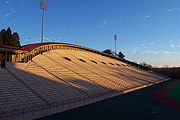 A important factor in the amount of the open space on the central campus was the gift in 1902 of the alumni fields, which the Alumni leveled to provide athletic playing areas in exchange for a promise that it would remain forever open for that purpose. In 1910, the expansion of the Ag School south of Tower Road caused the Trustees and the Alumni Field Committee to agree to exchange the east end of the fields (the site of Stocking Hall) for the area which now includes Schoellkopf Field
A important factor in the amount of the open space on the central campus was the gift in 1902 of the alumni fields, which the Alumni leveled to provide athletic playing areas in exchange for a promise that it would remain forever open for that purpose. In 1910, the expansion of the Ag School south of Tower Road caused the Trustees and the Alumni Field Committee to agree to exchange the east end of the fields (the site of Stocking Hall) for the area which now includes Schoellkopf Field
and Hoy Field
.
Athletic buildings constructed in this area include: Schoellkopf Field
(with Schoellkopf Memorial Hall (with a 2006 east wing), the Crescent (1914 with an expansion in 1923), and Paul Schoellkopf House for Visiting Teams), Grumman Squash Courts, Teagle
Hall, Lynah Hockey Rink
, Bacon Cage (since demolished) In the 1920s when Cornell's football team was national champion, the football stadium was filled to capacity with spectators. In 1960s, the Wilson
Synchrotron Laboratory was constructed in a tunnel 15 meters underneath Upper Alumni Fields. For many years, a cider track was located on Upper Alumni Fields to the east of Lynah Rink, but the 151900 sq ft (14,112 m²) Bartels Hall field house designed by Gwathmey
& Siegel (1990), and the Friedman Wrestling Center (2002) were built on the site of that track. A replacement track and field complex, named for Robert J. Kane
and William E. Simon
was built on the east end of Upper Alumni Fields in 1996.
In the 1970s, a new quadrangle was planned for Lower Alumni Field to house the since-dissolved Division of Biological Sciences. Three buildings were built on that playing field: the 110380 sq ft (10,254.6 m²) "new" Comstock
Hall (1985), Seeley G. Mudd Hall - Dale R. Corson
Hall (1982), and the 173818 sq ft (16,148.2 m²) Biotechnology Building (1986). In addition, Weill Hall (2008), a $162 million Life Sciences Technology Building, designed by Richard Meier
was built on the west end of Upper Alumni Field. Weill Hall includes the Fuller Learning Center with extensive video conferencing equipment.
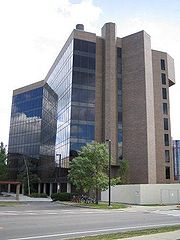 The enabling legislation creating the college also provided funds for a veterinary building at Cornell. The building opened in the fall of 1896, and is now a portion of Ives Hall
The enabling legislation creating the college also provided funds for a veterinary building at Cornell. The building opened in the fall of 1896, and is now a portion of Ives Hall
. A new veterinary complex for Cornell and the college was created in 1957 at the east end of Tower Road. The main building is named Schurman Hall. Today, this complex is the largest veterinary complex in higher education in the United States. (To compensate for the extra distance of the veterinary school from the center of the campus, a sound system was installed to amplify the chimes in Uris Library on that campus. Later, the system was extended to also play in the lobby of the Statler Inn.) In 1974, a 125460 sq ft (11,655.6 m²) Vet Research Tower (originally called the "Multicategorical Research Tower") was added with special central facilities to house animals for lab experiments. Its high-rise design by Ulrich Franzen balances Bradfield Hall.
In 1976, a Veterinary Diagnostic Lab was added to provide support for veterinarians throughout New York State. It was designed by Levatich, Miller & Hoffman. In 1993, a Primary Vet Teaching wing was added. In 1997, a 321395 sq ft (29,858.6 m²) Vet Hospital was added along the south side of the complex.
Adjacent to Schurman Hall is the W. C. Muenscher Poisonous Plant Garden, used by veterinary students to learn about plants poisonous to livestock. For many years, the garden included Cannabis
plants.
In 1978, a new 116854 sq ft (10,856.1 m²) building designed by Ulrich Franzen was built next to the Cornell Veterinary School to house the Boyce Thompson Institute for Plant Research
.
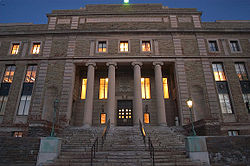 The need for additional science labs caused the Arts College to expand to the east side of East Avenue, displacing faculty housing. Science buildings, in order of construction, are:
The need for additional science labs caused the Arts College to expand to the east side of East Avenue, displacing faculty housing. Science buildings, in order of construction, are:
A new $85 million joint chemistry-physics building is currently under construction in the courtyard between Baker Lab and Rockefeller Hall and is expected to be completed in the Fall of 2010.
Also located in this area are Andrew Dickson White's house
, the only remaining faculty residence, now housing the Society for the Humanities, and the Big Red Barn, which was White's horse barn.
Malott
Hall, which was built to house the Business School, now houses the Mathematics Department. Across Forest Home Drive and downhill from these buildings, are the Hydraulics Lab (1896, rebuilt 1961-62, collapsed 2009), the Weinhold Chilled Water Plant, and the Toboggan Lodge (which housed toboggan and ice skating but now serves as a University Auditors office.)
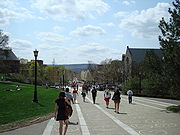
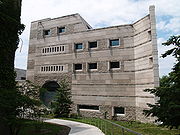
 The area between the Arts Quad and the Engineering Quad include a number of major buildings (listed from west to east): Willard Straight Hall
The area between the Arts Quad and the Engineering Quad include a number of major buildings (listed from west to east): Willard Straight Hall
, Gannett Health Services, Barnes
Hall
, the underground Cornell Campus Store designed by Earl Flansburgh
, Sage Chapel
, Sage Hall
(which was originally a women's dormitory and is now home to the Business School
), Day
Hall (the administration building), corten steel-clad Uris
Hall (social sciences), Statler Hall (which houses the Hotel School
), Irving Ives
Hall (which houses the Industrial and Labor Relations School
), and Barton Hall
, the armory/drill hall. The ILR extension building, located between Ives and Barton Halls, was renamed Dolgen Hall in 2008. Dolgen Hall as well as the southwest portion of Ives Hall were built to house the Veterinary School until 1957.
The open spaces in the area are enhanced by the "Wee Stinky Glen" (a creek and ravine), Ho Plaza on a portion of what was Central Avenue, George Peter
Plaza (between Statler and Uris Halls), the Ruth Uris Garden, the Livingston Farrand Garden, and the Mary Rockwell Azalea Garden.
On the southwest corner of Campus Road and Central Avenue are Anabel Taylor Hall (1953, the home of the Cornell United Religious Works) and Myron Taylor Hall (1932, the home of the Law School). They form a harmonious quadrangle in the Collegiate Gothic
style.
Across Cascadilla Gorge from the Law School, at the edge of College Town, are two major Cornell structures, historic Cascadilla Hall, now serving as an undergraduate dormitory, and the Schwartz Center for the Performing Arts. Designed by architect James Stirling
(considered to be the most important British architect of the 20th century), the marble- and stucco-clad performing arts building features a loggia running alongside the gorge, from which one enters the complex. It is one of only four structures in the U.S. designed by Stirling.
The general trend has been to preserve the central campus as a pedestrian space, and parking lots have been eliminated and used as sites for new buildings. In 1969, daytime traffic across the central campus was restricted to holders of special staff parking permits. A campus bus system shuttled commuters to peripheral "A" and "B" parking lots, with the cost of the parking permits covering the operating cost of the bus system.
Subsequently, the western end of Tower Road was permanently closed to all traffic as was Central Avenue, which was developed into Ho Plaza.
However, staff continue to press for more parking on the central campus, and in response, parking structures have been built on the site of Bacon Cage on the south and on the site of the North Wing of MVR on the north. Plans to build a third garage on the Hughes Hall parking lot have been defeated. Proposals for new parking lots have generally draw protests from neighbors as indicated by the Redbud Woods controversy
in 2005.
The future of Cornell's transportation needs is currently undergoing a generic environmental impact study.
. On the north, pedestrians can cross the Stewart Avenue bridge which overlooks the Ithaca Falls. Just above the falls is the windowless former clubhouse of Sphinx Head
. Adjacent to the Johnson Art Museum is a pedestrian suspension bridge (1960) designed by Dean S.C. Hollister and William McGuire. It replaces an earlier version constructed in 1913. Between Rand and Risley Halls is the Thurston Avenue Bridge which overlook Triphammer Dam and Beebe Lake. Adjacent to the dam is another pedestrian bridge which was originally constructed to serve the trolley lines. Finally at the east end of Beebe Lake is the Sackett footbridge.
On the south, pedestrians can cross Cascadilla Gorge over the Stewart Avenue bridge, the College Avenue Bridge, a pedestrian bridge originally built for trolleys, the Eddy Dam bridge, and the Hoy Road/Dwyer Dam bridge.
Cornell University
Cornell University is an Ivy League university located in Ithaca, New York, United States. It is a private land-grant university, receiving annual funding from the State of New York for certain educational missions...
's Ithaca, New York
Ithaca, New York
The city of Ithaca, is a city in upstate New York and the county seat of Tompkins County, as well as the largest community in the Ithaca-Tompkins County metropolitan area...
campus. It is bounded by Libe Slope on the west, Fall Creek on the north, and Cascadilla Creek on the South.
History
Ezra CornellEzra Cornell
Ezra Cornell was an American businessman and education administrator. He was a founder of Western Union and a co-founder of Cornell University...
donated his farm for the site of the Cornell University
Cornell University
Cornell University is an Ivy League university located in Ithaca, New York, United States. It is a private land-grant university, receiving annual funding from the State of New York for certain educational missions...
as a part of the package to bring New York's land grant college to Ithaca. With the exception of Cascadilla Hall, no buildings were on the site so the campus evolved based on the hilly terrain and the conflicting visions of its designers, starting with Ezra Cornell and Andrew Dickson White
Andrew Dickson White
Andrew Dickson White was a U.S. diplomat, historian, and educator, who was the co-founder of Cornell University.-Family and personal life:...
.
Over the years, the Buildings and Properties Committee of Cornell's Board of Trustees has maintained the stewardship of campus planning supported by a Vice President for Planning, Planning Office, and in recent years, a University Architect. Periodically, outside architects and consultants, beginning with Frederick Olmsted have been commissioned to develop master plans. Because the entire campus is subject to a special class of zoning, land use decisions are largely made internally rather than by the Ithaca zoning process. However, construction or renovation of statutory college
Statutory college
In American higher education, particular to the state of New York, a statutory college or contract college is a college or school that is a component of an independent, private university that has been designated by the state legislature to receive significant, ongoing public funding from the state...
buildings are subject to additional planning steps involving the New York State University Construction Fund
State University Construction Fund
The State University Construction Fund is a New York State agency addressing the construction and capital planning needs of the State University of New York and affiliated institutions....
Office.
In 2006-2007, Cornell embarked on another in its series of master plans, retaining Urban Strategies Inc. of Toronto as a consultant.
Historically, Cornell has been reluctant to demolish its buildings, but has repeatedly renovated and found new uses for old structures. Morrill Hall
Morrill Hall
Justin Morrill Hall, known almost exclusively as Morrill Hall, is an academic building of Cornell University on its Ithaca, New York campus. As of 2009 it houses the Departments of Romance Studies, Russian Literature, and Linguistics...
is a National Historic Landmark. In 1971, Ithaca adopted a pioneering landmark and historic preservation ordinance, with the Arts Quadrangle and a number of individual buildings being designated landmarks or historic districts. Registered historic places on the central campus include: Andrew Dickson White House
Andrew Dickson White House
The Andrew Dickson White House, commonly referred to as the "A.D. White House," is a Second Empire house on the campus of Cornell University, designed by William Henry Miller and Charles Babcock...
, Bailey Hall, Caldwell Hall, old Comstock Hall
Comstock Hall, Cornell University
Comstock Hall is a building of Cornell University. It was built in 1911 and listed on the National Register of Historic Places in 1984. It was designed by Green & Wicks....
, Deke House, East Roberts Hall
East Robert Hall (Ithaca, New York)
East Roberts Hall was a building on the campus of Cornell University in Ithaca, New York. It no longer exists.It was listed on the U.S. National Register of Historic Places in 1984...
(demolished), Fernow Hall, Rice Hall, Roberts Hall
Roberts Hall (Ithaca, New York)
Roberts Hall is a building on the Ag Quad of Cornell University, and is the second building of that name. The original Roberts Hall was built in 1906, and was listed on the U.S. National Register of Historic Places in 1984. The 1906-built Roberts Hall was demolished before the construction of the...
(demolished) and Stone Hall
Stone Hall (Ithaca, New York)
Stone Hall was a building on the campus of Cornell University in Ithaca, New York, named after John Lemuel Stone, a CALS professor of farm practice during the early 1900s. It no longer exists....
(demolished). The two Norwegian spurce trees in front of the Deke House planted by Theodore Roosevelt
Theodore Roosevelt
Theodore "Teddy" Roosevelt was the 26th President of the United States . He is noted for his exuberant personality, range of interests and achievements, and his leadership of the Progressive Movement, as well as his "cowboy" persona and robust masculinity...
are on the National Register of Historically Significant Trees. The campus includes more recent, 20th-century buildings that have earned architectural acclaim, especially the I. M. Pei-designed Johnson Art Museum and James Stirling
James Stirling (architect)
Sir James Frazer Stirling FRIBA was a British architect. He is considered to be among the most important and influential British architects of the second half of the 20th century...
-designed Schwartz Performing Arts Center.
Arts Quadrangle



Hiram Sibley
Hiram Sibley , was an industrialist, entrepreneur, and philanthropist.Sibley was born in North Adams, Massachusetts, and later resided in Rochester, New York. He became interested in the work of Samuel Morse involving the telegraph.In 1840, he joined with Morse and Ezra Cornell to create a...
(1870) Halls were designed by Syracuse architect Archimedes Russell. There were tensions between Cornell's preference for practical designs while White favored a more classical design. Hence although the Stone Row was built from native gray silt stone (nicknamed "llenroc"), later buildings including Lincoln Hall, Sage Residential College
Sage Residential College
Sage Hall was built in 1875 at Cornell University's Ithaca, New York campus. It was originally designed to be a residential building, however, currently it houses the Johnson Graduate School of Management...
and Sage Chapel
Sage Chapel
Sage Chapel is the non-denominational chapel on the campus of Cornell University in Ithaca, New York State and serves as the final resting place of the university's founders, Ezra Cornell and Andrew Dickson White, and their wives...
were built from red brick. Originally, the Arts Quadrangle was proposed to be a square extending to the east to the site of Baker Laboratory and Rockefeller Hall. However, the subsequent construction of Lincoln Hall and Goldwin Smith Hall ended up defining it as a rectangle, with its long dimension oriented North-South.
By 1871 Cornell had established one of the United States' early architecture schools, and many campus buildings built in the last quarter of the Nineteenth Century were designed by the architecture school's professors and students. Hence, Cornell's first architecture professor, Charles Babcock
Charles Babcock
Charles Babcock was a United States architect, academic, Episcopal priest and founding member of the American Institute of Architects....
, received many important commissions. Franklin
Benjamin Franklin
Dr. Benjamin Franklin was one of the Founding Fathers of the United States. A noted polymath, Franklin was a leading author, printer, political theorist, politician, postmaster, scientist, musician, inventor, satirist, civic activist, statesman, and diplomat...
(1882; now Tjaden) and Lincoln
Abraham Lincoln
Abraham Lincoln was the 16th President of the United States, serving from March 1861 until his assassination in April 1865. He successfully led his country through a great constitutional, military and moral crisis – the American Civil War – preserving the Union, while ending slavery, and...
(1888) Halls reflect Babcock's interpretation of the Romanesque Revival style. William H. Miller
William Henry Miller (architect)
William Henry Miller was an American architect and the first graduate of the architecture school at Cornell University in Ithaca, New York.Born in 1848 in Trenton, New York, Miller graduated from Cornell in 1872...
, who studied architecture under Cornell President Andrew D. White, also employed the Romanesque Revival
Romanesque Revival architecture
Romanesque Revival is a style of building employed beginning in the mid 19th century inspired by the 11th and 12th century Romanesque architecture...
style in the design of Uris
Harold Uris
Harold D. Uris was an American builder, real estate investor and philanthropist. After earning a civil engineering degree from Cornell in 1925, Harold joined his brother, Percy, who had a 1920 business degree from Columbia University, and their father, Harris, founder of an ornamental ironwork...
Library (dedicated 1891), which has grown to iconically represent Cornell. Uris Library was expanded from its original cross shape twice—first to expand the library stacks and more recently to add underground reading rooms overlooking Libe Slope. Miller's Stimson Hall (1902), and the Sibley
Hiram Sibley
Hiram Sibley , was an industrialist, entrepreneur, and philanthropist.Sibley was born in North Adams, Massachusetts, and later resided in Rochester, New York. He became interested in the work of Samuel Morse involving the telegraph.In 1840, he joined with Morse and Ezra Cornell to create a...
Dome (1902), by Arthur N. Gibb (who also graduated from the Cornell architecture school), reflect Neoclassical themes. Cornell shifted to outside architects, the nationally prominent firm of Carrère and Hastings
Carrère and Hastings
Carrère and Hastings, the firm of John Merven Carrère and Thomas Hastings , located in New York City, was one of the outstanding Beaux-Arts architecture firms in the United States. The partnership operated from 1885 until 1911, when Carrère was killed in an automobile accident...
, to design Goldwin Smith Hall (1904) and the adjacent Sheldon Memorial Exedra and Sundial (installed 1910), also in a Neoclassical style. Goldwin Smith Hall began as a modest building with an east-west orientation, but the 1904 expansion to its south converted it into the focal point of the east side of the Quad.
Next to Stimson Hall was Miller-designed Boardman Hall, constructed to house the Law School
Cornell Law School
Cornell Law School, located in Ithaca, New York, is a graduate school of Cornell University and one of the five Ivy League law schools. The school confers three law degrees...
in 1892, anchored the south end of the Quad until it was demolished in 1959.

John M. Olin
John Merrill Olin was an American businessman. He was the son of Franklin W. Olin.-Early life:Born in Alton, Illinois, Olin graduated from Cornell University with a B.Sc. degree in chemistry and as a brother of the Kappa Sigma Fraternity...
Graduate Library (1960) , designed by Warner, Burns, Toan & Lunde. The last addition to the Arts Quad is the Carl Kroch
Kroch’s and Brentano’s
Kroch's and Brentano's was the largest bookstore in Chicago, and at one time the largest privately owned bookstore chain in the United States. It closed in 1995....
Library, which opened on August 24, 1992. The building is underground between Stimson, Olin Library and Goldwin Smith Halls. A new wing for the Sidney Cox Library of Music and Dance was added to the rear of Lincoln Hall in 2000
To the west of White Hall is the Herbert F. Johnson Museum of Art
Herbert F. Johnson Museum of Art
The Herbert F. Johnson Museum of Art is an art museum located on the northwest corner of the Arts Quad on the main campus of Cornell University in Ithaca, New York. It is most well known for its distinctive concrete facade, its collection which includes two windows from Frank Lloyd Wright's Darwin...
(1973) designed by I.M. Pei. The original design included an underground Asian art gallery which overlooked the gorge. However, this gallery was dropped due to funding. However, in response to a dramatic increase in the museum's collection, an altered version of that addition, totalling 16000 square feet (1,486.4 m²) is under construction to the north of the existing building. Previously, Morse Hall stood next to Franklin/Tjaden Hall, but it was destroyed by a fire.
Minor support buildings include Rand Hall (1911) designed by Gibb and Walts and the Foundry (1883). Finally, Milstein
Paul Milstein
Paul Milstein was a real estate developer and philanthropist.Born in New York City he attended DeWitt Clinton High School and the New York University School of Architecture. The family enterprises began with Morris Milstein, who emigrated to the United States from Russia and founded Circle Floor...
Hall, a new 43000 square feet (3,994.8 m²) facility designed by Rem Koolhaas
Rem Koolhaas
Remment Lucas Koolhaas is a Dutch architect, architectural theorist, urbanist and "Professor in Practice of Architecture and Urban Design" at the Graduate School of Design at Harvard University, USA. Koolhaas studied at the Netherlands Film and Television Academy in Amsterdam, at the Architectural...
will be built on the parking lot behind Sibley Hall. During 2007-2010, while Milstein Hall was pending, second year architecture students used rented studio space on Esty Street.
The landscaping of the Arts Quad is mostly informal and was historically dominated by towering elm trees. After Dutch elm disease
Dutch elm disease
Dutch elm disease is a disease caused by a member of the sac fungi category, affecting elm trees which is spread by the elm bark beetle. Although believed to be originally native to Asia, the disease has been accidentally introduced into America and Europe, where it has devastated native...
swept the campus, a new row of Zelcova trees was planted in the 1970s along the sidewalk on the eastern edge of the quad. These trees were selected for their vase shape (which are similar to elms trees), but unfortunately grow much slower than the elms which they replaced. The sidewalk on the northern edge is also significant because I.M. Pei aligned window slots in the Art Museum on the sidewalk's axis to preserve a view of West Hill through the museum.
Engineering Quadrangle

Perkins and Will
Perkins+Will was founded in Chicago in 1935 by and ., on the belief that design has the power to transform lives and enhance society...
firm. It has undergone major changes in recent years, particularly with the completion of Duffield Hall. Prior to its construction, Engineering programs were housed in Lincoln Hall, Sibley Hall, Morse Hall and Franklin Hall at the north end of the Arts Quad. In 2004, relandscaping with a design inspired by Cascadilla Gorge was completed and its landmark sundial
Sundial
A sundial is a device that measures time by the position of the Sun. In common designs such as the horizontal sundial, the sun casts a shadow from its style onto a surface marked with lines indicating the hours of the day. The style is the time-telling edge of the gnomon, often a thin rod or a...
(designed by Dale Corson) was restored to its rightful place on the quad (after having been stored in Upson Hall during the construction period). Also, modern and open collaborative working spaces were introduced with the construction of a large atrium
Atrium (architecture)
In modern architecture, an atrium is a large open space, often several stories high and having a glazed roof and/or large windows, often situated within a larger multistory building and often located immediately beyond the main entrance doors...
connecting Duffield, which houses research and teaching facilities for nanoscale science and engineering, with Phillips and Upson (1956) Halls. Connected to Upson Hall, away from the quad, are Grumman Hall (1957), which was built to house a Graduate School of Areospace Engineering, and Frank H.T. Rhodes Hall designed by Gwathmey
Charles Gwathmey
Charles Gwathmey was an American architect. He was a principal at Gwathmey Siegel & Associates Architects, as well as one of the five architects identified as The New York Five in 1969...
& Siegel (1990), which currently houses the Cornell Theory Center
Cornell Theory Center
The Cornell University Center for Advanced Computing , housed at Franklin H.T. Rhodes Hall on the campus of Cornell University, is one of five original centers in the National Science Foundation's Supercomputer Centers Program...
. On the southern end of the Quad, next to Upson and near Cascadilla Creek, are Kimball, Thurston and Bard (1963) Halls, all part of a single brick and concrete structure. Thurston is the home to the Theoretical and Applied Mathematics department, and Bard Hall the home of the Material Sciences department. Between Upson and Kimball stands Ward Hall (1963), the soon to be closed down and former building for nuclear sciences. Next to Bard, and across the street from the Cornell Law School
Cornell Law School
Cornell Law School, located in Ithaca, New York, is a graduate school of Cornell University and one of the five Ivy League law schools. The school confers three law degrees...
, stand Snee Hall (1984), which houses the Geology Department, and Hollister Hall, (1957) which houses Civil Engineering. Carpenter Hall (1956), containing the Engineering Library, stands next to Hollister on the northwestern corner. The edge of northern face of the quad, mostly open space, is lined with trees along Campus Road. Across Campus Road is F.W. Olin
Franklin W. Olin
Franklin Walter Olin was the founder of the Olin Corporation.He was born in Woodford, Vermont and his father built mills and waterwheels. He studied civil engineering at Cornell University, where he also played baseball; he would play as an outfielder in the American Association for two seasons...
Hall (1941) the home of the Chemical Engineering department.
Future developments
With the receipt of a $25 million grant from the Bill and Melinda Gates Foundation in 2006, the college is looking to add a new William H. Gates Hall to house the Department of Computer Science, as well as portions of the Theory Center and Program of Computer Graphics. In addition, the university is also planning to build an information campus based on the Gates building, and other buildings potentially, depending on the receipt of additional grants.Main Ag Quadrangle

Cornell University College of Agriculture and Life Sciences
The New York State College of Agriculture and Life Sciences is a statutory college at Cornell University, a private university located in Ithaca, New York...
. It is a quadrangle
Quadrangle (architecture)
In architecture, a quadrangle is a space or courtyard, usually rectangular in plan, the sides of which are entirely or mainly occupied by parts of a large building. The word is probably most closely associated with college or university campus architecture, but quadrangles may be found in other...
east of the Arts Quad and west of the College of Veterinary Medicine
Cornell University College of Veterinary Medicine
The New York State College of Veterinary Medicine at Cornell University was founded in 1894. It was the first statutory college in New York. Before the creation of the college, instruction in veterinary medicine had been part of Cornell's curriculum since the university's founding...
. The oldest building still standing on the quad is Caldwell Hall, in the Colonial Revival style which opened in 1913. The Plant Science Building opened in 1931 and Warren Hall, across from Plant Science, opened in the next year, The art deco
Art Deco
Art deco , or deco, is an eclectic artistic and design style that began in Paris in the 1920s and flourished internationally throughout the 1930s, into the World War II era. The style influenced all areas of design, including architecture and interior design, industrial design, fashion and...
style Mann Library on the eastern end of the quad, connecting Warren Hall on the north to the Plant Sciences Building on the south, opened in 1952. Between Plant Science and Tower Road is the greenhouses built in 1931 to house Liberty Hide Bailey's palm collection and the Minns Garden. Designed by Gwathmey
Charles Gwathmey
Charles Gwathmey was an American architect. He was a principal at Gwathmey Siegel & Associates Architects, as well as one of the five architects identified as The New York Five in 1969...
& Siegel and completed in 1990, Keith Kennedy and the "new" Roberts Halls, featuring an archway that connects the two halls, extend along the western face of the quad, having replaced the original Roberts Hall (1906) and East Roberts Hall and Stone
John Lemuel Stone
John Lemuel Stone was a pioneer in agriculture education.Stone was born in 1852 in Waverly Township, Pennsylvania, where he grew up on his family's farm. He was one of three agriculture students enrolled at Cornell University Agriculture School, when Isaac P Roberts arrived to serve as dean in 1874...
Hall. The Computing and Communications Center
Comstock Hall, Cornell University
Comstock Hall is a building of Cornell University. It was built in 1911 and listed on the National Register of Historic Places in 1984. It was designed by Green & Wicks....
(formerly named Comstock Hall), which was designed by Cornell faculty members, Clarence Martin, Jean Hebrard, and George Young, stands between Roberts and Caldwell Halls. The quad now opens toward the south with the Minns Garden between Roberts and Plant Science.

The most recent addition has been a 105372 sq ft (9,789.4 m²) expansion of Mann Library to the northeast, designed by Lee Timchula and opened in 2000.
Human Ecology
Since 1933, the home economics/human ecologyCornell University College of Human Ecology
The New York State College of Human Ecology is a statutory college at Cornell University. The college is a unique compilation of studies on consumer science, nutrition, health economics, public policy, human development and textiles, each part of the discipline of human ecology.Students at the...
programs have been housed in Martha Van Renssalaer Hall (MVR), a 171648 sq ft (15,946.6 m²) Georgian Revival style brick building designed by William Haugaard located between the Ag Quad and Beebe Lake. In 1968, a dramatic, cantilevered wing designed by Ulrich Franzen was added to the North side of MVR overlooking Beebe Lake. However, the building was declared structurally unsafe in 2001 and abandoned. In the meantime, a west wing was built to house the human nutrition labs as a link between the main MVR and the north wing, but it opened in 2002, after the north wing was closed. The North wing was demolished in 2006, and construction began in 2008 to replace it with an 88228 square feet (8,196.6 m²) teaching and laboratory building atop a 290 car parking garage. The lead architect is Darko Hreljanovic, a 1977 graduate of Cornell's architecture college. The new building will open in 2012.
Eastern Buildings

New York State College of Forestry at Cornell
The New York State College of Forestry at Cornell was a statutory college established in 1898 at Cornell University to teach scientific forestry. The first four-year college of forestry in the country, it was defunded by the State of New York in 1903, over controversies involving the college's...
to house an environmental sciences program. Other buildings are:
- The Poultry Houses
- Bruckner Lab
- Rice Hall (1912)
- Beebe Hall
- The Insectary Complex
- The Kenneth Post Greenhouses
- Dimock Lab
- Federal Nutrition Lab (and greenhouses) houses programs of the U. S. Department of Agriculture. Just south of the Plant Sciences Building is the Minns Garden.
South of Tower Road
Across Tower Road on the south side at the east end of Alumni Fields are:- Stocking Hall with the Dairy BarCornell DairyCornell Department of Food Sciences Dairy Operations or Cornell Dairy is about a 25 minute drive from Cornell University's Ithaca, New York campus and is home to over 900 milk-producing cows. The milk is used to make various signature products, including ice cream, cheese, and yogurt, which are...
- Wing Hall (Wing Hall is statutory and owned by NY State, but its 1965 wing is endowed and owned by Cornell)
- Riley-Robb Hall (Biological engineering)
- Morrison Hall (1961)
- Nematode Lab (1937)
Alumni Fields, Athletics and Biology Buildings

Schoellkopf Field
Schoellkopf Field is a 25,597-capacity stadium at Cornell University's Ithaca-campus that opened in 1915 and is used for the Cornell Big Red football, sprint football, lacrosse and field hockey teams...
and Hoy Field
Hoy Field
David F. Hoy Field, usually referred to simply as Hoy Field, is a baseball field at Cornell University in Ithaca, New York, where the Big Red's baseball team plays...
.
Athletic buildings constructed in this area include: Schoellkopf Field
Schoellkopf Field
Schoellkopf Field is a 25,597-capacity stadium at Cornell University's Ithaca-campus that opened in 1915 and is used for the Cornell Big Red football, sprint football, lacrosse and field hockey teams...
(with Schoellkopf Memorial Hall (with a 2006 east wing), the Crescent (1914 with an expansion in 1923), and Paul Schoellkopf House for Visiting Teams), Grumman Squash Courts, Teagle
Walter C. Teagle
Walter Clark Teagle , was responsible for leading Standard Oil to the forefront of the oil industry and significantly expanding the company's presence in the petrochemical field.-Biography:...
Hall, Lynah Hockey Rink
Lynah Rink
Lynah Rink is a 4,267-seat hockey arena at Cornell University in Ithaca, New York, that opened in 1957. Named after James Lynah, Class of 1905, who was the director of Cornell athletics from 1935-1943, it is home to the Big Red men's and women's ice hockey teams.Lynah has been home to hockey greats...
, Bacon Cage (since demolished) In the 1920s when Cornell's football team was national champion, the football stadium was filled to capacity with spectators. In 1960s, the Wilson
Robert R. Wilson
Robert Rathbun Wilson was an American physicist who was a group leader of the Manhattan Project, a sculptor, and an architect of Fermi National Laboratory , where he was also the director from 1967–1978....
Synchrotron Laboratory was constructed in a tunnel 15 meters underneath Upper Alumni Fields. For many years, a cider track was located on Upper Alumni Fields to the east of Lynah Rink, but the 151900 sq ft (14,112 m²) Bartels Hall field house designed by Gwathmey
Charles Gwathmey
Charles Gwathmey was an American architect. He was a principal at Gwathmey Siegel & Associates Architects, as well as one of the five architects identified as The New York Five in 1969...
& Siegel (1990), and the Friedman Wrestling Center (2002) were built on the site of that track. A replacement track and field complex, named for Robert J. Kane
Robert Kane (sports administrator)
Robert Kane was a celebrated sports administrator.Kane attended Ithaca High School and Cornell University, where he established himself as a talented sprinter. As a senior at Cornell, he was elected to the Sphinx Head Society....
and William E. Simon
William E. Simon
William Edward Simon was a businessman, a Secretary of Treasury of the U.S. for three years, and a philanthropist. He became the 63rd Secretary of the Treasury on May 8, 1974, during the Nixon administration. He was reappointed by President Ford and served until 1977. Outside of government, he was...
was built on the east end of Upper Alumni Fields in 1996.
In the 1970s, a new quadrangle was planned for Lower Alumni Field to house the since-dissolved Division of Biological Sciences. Three buildings were built on that playing field: the 110380 sq ft (10,254.6 m²) "new" Comstock
John Henry Comstock
John Henry Comstock was an eminent researcher in entomology and arachnology and a leading educator. His work provided the basis for classification of butterflies, moths, and scale insects.-Early life and education:...
Hall (1985), Seeley G. Mudd Hall - Dale R. Corson
Dale R. Corson
Dale R. Corson was the eighth president of Cornell University. Born in Pittsburg, Kansas, in 1914, Corson received a B.A. degree from the College of Emporia in 1934, his M.A. degree from the University of Kansas in 1935, and his Ph.D...
Hall (1982), and the 173818 sq ft (16,148.2 m²) Biotechnology Building (1986). In addition, Weill Hall (2008), a $162 million Life Sciences Technology Building, designed by Richard Meier
Richard Meier
Richard Meier is an American architect, whose rationalist buildings make prominent use of the color white.- Biography :Meier is Jewish and was born in Newark, New Jersey...
was built on the west end of Upper Alumni Field. Weill Hall includes the Fuller Learning Center with extensive video conferencing equipment.
Veterinary Medicine

Irving Ives
Irving McNeil Ives was an American politician from New York.-Life:He served overseas in the U.S. Army during World War I, rising to the rank of first lieutenant before he left the army in 1919...
. A new veterinary complex for Cornell and the college was created in 1957 at the east end of Tower Road. The main building is named Schurman Hall. Today, this complex is the largest veterinary complex in higher education in the United States. (To compensate for the extra distance of the veterinary school from the center of the campus, a sound system was installed to amplify the chimes in Uris Library on that campus. Later, the system was extended to also play in the lobby of the Statler Inn.) In 1974, a 125460 sq ft (11,655.6 m²) Vet Research Tower (originally called the "Multicategorical Research Tower") was added with special central facilities to house animals for lab experiments. Its high-rise design by Ulrich Franzen balances Bradfield Hall.
In 1976, a Veterinary Diagnostic Lab was added to provide support for veterinarians throughout New York State. It was designed by Levatich, Miller & Hoffman. In 1993, a Primary Vet Teaching wing was added. In 1997, a 321395 sq ft (29,858.6 m²) Vet Hospital was added along the south side of the complex.
Adjacent to Schurman Hall is the W. C. Muenscher Poisonous Plant Garden, used by veterinary students to learn about plants poisonous to livestock. For many years, the garden included Cannabis
Cannabis
Cannabis is a genus of flowering plants that includes three putative species, Cannabis sativa, Cannabis indica, and Cannabis ruderalis. These three taxa are indigenous to Central Asia, and South Asia. Cannabis has long been used for fibre , for seed and seed oils, for medicinal purposes, and as a...
plants.
In 1978, a new 116854 sq ft (10,856.1 m²) building designed by Ulrich Franzen was built next to the Cornell Veterinary School to house the Boyce Thompson Institute for Plant Research
Boyce Thompson Institute for Plant Research
The Boyce Thompson Institute for Plant Research is a research and education organization devoted to plant science currently located on the campus of Cornell University in Ithaca, New York...
.
Science Buildings

- RockefellerJohn D. RockefellerJohn Davison Rockefeller was an American oil industrialist, investor, and philanthropist. He was the founder of the Standard Oil Company, which dominated the oil industry and was the first great U.S. business trust. Rockefeller revolutionized the petroleum industry and defined the structure of...
Hall (1904 & 1980, physics) - red brick classroom building designed by Carrère and HastingsCarrère and HastingsCarrère and Hastings, the firm of John Merven Carrère and Thomas Hastings , located in New York City, was one of the outstanding Beaux-Arts architecture firms in the United States. The partnership operated from 1885 until 1911, when Carrère was killed in an automobile accident...
. - Baker Lab (1921, chemistry) - stone building designed by Gibb & Day
- Savage Hall (1948, nutrition) - designed by Skidmore, Owings & Merrill
- Floyd R. Newman Lab (1947, physics) - contained Cornell's first particle accelerator prior to Wilson Lab.
- Clark Hall (1965, material science and physical science library) - designed by Warner, Toan & Lunde
- Spencer T. Olin Chemistry Research Lab (1967)
- Space Sciences Building (1967, astronomy)
- Kinzelberg Hall (1988, nutrition) designed by King & King.
A new $85 million joint chemistry-physics building is currently under construction in the courtyard between Baker Lab and Rockefeller Hall and is expected to be completed in the Fall of 2010.
Also located in this area are Andrew Dickson White's house
Andrew Dickson White House
The Andrew Dickson White House, commonly referred to as the "A.D. White House," is a Second Empire house on the campus of Cornell University, designed by William Henry Miller and Charles Babcock...
, the only remaining faculty residence, now housing the Society for the Humanities, and the Big Red Barn, which was White's horse barn.
Malott
Deane Waldo Malott
Deane Waldo Malott was an American academic and administrator.The son of a banker, Malott was born in Abilene, Kansas and went on to study at the University of Kansas. While at school there, he wrote for the University Daily Kansan and was a brother in the Beta Theta Pi fraternity...
Hall, which was built to house the Business School, now houses the Mathematics Department. Across Forest Home Drive and downhill from these buildings, are the Hydraulics Lab (1896, rebuilt 1961-62, collapsed 2009), the Weinhold Chilled Water Plant, and the Toboggan Lodge (which housed toboggan and ice skating but now serves as a University Auditors office.)
Central Buildings



Willard Straight Hall
Willard Straight Hall is the student union building on the central campus of Cornell University in Ithaca, New York. It is located on Campus Road, adjacent to the Ho Plaza and the Gannett Health Center.-History:...
, Gannett Health Services, Barnes
Alfred Smith Barnes
__notoc__Alfred Smith Barnes was an American publisher and philanthropist. He was known as "the General".-Life and career:...
Hall
Barnes Hall
Barnes Hall is a student-services building located in the center of the Cornell University campus in Ithaca, New York. It was built in 1887 in a Romanesque style and has 21,618 sq ft.-History:...
, the underground Cornell Campus Store designed by Earl Flansburgh
Earl Flansburgh
Earl R. Flansburgh was an architect known for his extensive work in the Boston area.Flansburgh graduated from the Cornell Architecture School in 1953, where he was also a member of the Quill and Dagger society...
, Sage Chapel
Sage Chapel
Sage Chapel is the non-denominational chapel on the campus of Cornell University in Ithaca, New York State and serves as the final resting place of the university's founders, Ezra Cornell and Andrew Dickson White, and their wives...
, Sage Hall
Sage Residential College
Sage Hall was built in 1875 at Cornell University's Ithaca, New York campus. It was originally designed to be a residential building, however, currently it houses the Johnson Graduate School of Management...
(which was originally a women's dormitory and is now home to the Business School
S.C. Johnson Graduate School of Management
The Samuel Curtis Johnson Graduate School of Management is the graduate business school of Cornell University, a private Ivy League university located in Ithaca, New York. It was founded in 1946 and renamed in 1984 after Samuel Curtis Johnson, founder of S.C...
), Day
Edmund Ezra Day
Edmund Ezra Day was a U.S. educator.Day received his undergraduate and master's degrees from Dartmouth College and his doctorate in economics from Harvard. While at Dartmouth, be became a brother of Theta Delta Chi. He went on to serve as the fifth president of Cornell University from 1937 to 1949...
Hall (the administration building), corten steel-clad Uris
Harold Uris
Harold D. Uris was an American builder, real estate investor and philanthropist. After earning a civil engineering degree from Cornell in 1925, Harold joined his brother, Percy, who had a 1920 business degree from Columbia University, and their father, Harris, founder of an ornamental ironwork...
Hall (social sciences), Statler Hall (which houses the Hotel School
Cornell University School of Hotel Administration
The School of Hotel Administration at Cornell University is a specialized business school for hospitality management founded in 1922 as the first four-year intercollegiate school devoted to the field...
), Irving Ives
Irving Ives
Irving McNeil Ives was an American politician from New York.-Life:He served overseas in the U.S. Army during World War I, rising to the rank of first lieutenant before he left the army in 1919...
Hall (which houses the Industrial and Labor Relations School
Cornell University School of Industrial and Labor Relations
The New York State School of Industrial and Labor Relations is an industrial relations school at Cornell University, an Ivy League university located in Ithaca, New York, USA...
), and Barton Hall
Barton Hall
Barton Hall is an on-campus field house on the campus of Cornell University in Ithaca, New York. It is the site of the school's indoor track facilities, ROTC offices and classes, and Cornell Police. It's also the location of the band room, used by the Cornell Big Red Marching Band and the Cornell...
, the armory/drill hall. The ILR extension building, located between Ives and Barton Halls, was renamed Dolgen Hall in 2008. Dolgen Hall as well as the southwest portion of Ives Hall were built to house the Veterinary School until 1957.
The open spaces in the area are enhanced by the "Wee Stinky Glen" (a creek and ravine), Ho Plaza on a portion of what was Central Avenue, George Peter
George Peter (technician)
George Peter was an activist for employee rights at Cornell University.Peter was born in 1922 in Ithaca, New York. His father was an Armenian immigrant, who had a farm near the town and also worked in a quarry which extracted the Llenroc stone used to build Myron Taylor Hall...
Plaza (between Statler and Uris Halls), the Ruth Uris Garden, the Livingston Farrand Garden, and the Mary Rockwell Azalea Garden.
On the southwest corner of Campus Road and Central Avenue are Anabel Taylor Hall (1953, the home of the Cornell United Religious Works) and Myron Taylor Hall (1932, the home of the Law School). They form a harmonious quadrangle in the Collegiate Gothic
Gothic Revival architecture
The Gothic Revival is an architectural movement that began in the 1740s in England...
style.
Across Cascadilla Gorge from the Law School, at the edge of College Town, are two major Cornell structures, historic Cascadilla Hall, now serving as an undergraduate dormitory, and the Schwartz Center for the Performing Arts. Designed by architect James Stirling
James Stirling (architect)
Sir James Frazer Stirling FRIBA was a British architect. He is considered to be among the most important and influential British architects of the second half of the 20th century...
(considered to be the most important British architect of the 20th century), the marble- and stucco-clad performing arts building features a loggia running alongside the gorge, from which one enters the complex. It is one of only four structures in the U.S. designed by Stirling.
Parking and Traffic
Historically, students lived off campus and were expected to walk to campus, and faculty housing was available on the campus, so parking was not a major issue. A trolley line from downtown crossed the campus to provide public transportation. Later, a statute gave Cornell the power to regulate parking and traffic on its campus.The general trend has been to preserve the central campus as a pedestrian space, and parking lots have been eliminated and used as sites for new buildings. In 1969, daytime traffic across the central campus was restricted to holders of special staff parking permits. A campus bus system shuttled commuters to peripheral "A" and "B" parking lots, with the cost of the parking permits covering the operating cost of the bus system.
Subsequently, the western end of Tower Road was permanently closed to all traffic as was Central Avenue, which was developed into Ho Plaza.
However, staff continue to press for more parking on the central campus, and in response, parking structures have been built on the site of Bacon Cage on the south and on the site of the North Wing of MVR on the north. Plans to build a third garage on the Hughes Hall parking lot have been defeated. Proposals for new parking lots have generally draw protests from neighbors as indicated by the Redbud Woods controversy
Redbud Woods controversy
The Redbud Woods controversy was a dispute between protesters and the administration of Cornell University in Ithaca, New York over the demolition of a patch of woodlands known as the "Redbud Woods." The area received this name because of the many Redbud trees that grew there and whose blossoms...
in 2005.
The future of Cornell's transportation needs is currently undergoing a generic environmental impact study.
Pedestrian Access
Because the central campus is flanked by two gorges, on the north and south and a steep hill on the west, access is scenic. Many undergraduates climb Libe Slope from the Cornell West CampusCornell West Campus
West Campus is a residential section of Cornell University's Ithaca, New York campus located west of Libe Slope and between the Fall Creek gorge and the Cascadilla gorge. It now primarily houses transfer students, second year, and upperclassmen. West Campus is currently part of a residential...
. On the north, pedestrians can cross the Stewart Avenue bridge which overlooks the Ithaca Falls. Just above the falls is the windowless former clubhouse of Sphinx Head
Sphinx Head
The Sphinx Head Society is the oldest senior honor society at Cornell University. Sphinx Head recognizes Cornell senior men and women who have demonstrated respectable strength of character on top of a dedication to leadership and service at Cornell University...
. Adjacent to the Johnson Art Museum is a pedestrian suspension bridge (1960) designed by Dean S.C. Hollister and William McGuire. It replaces an earlier version constructed in 1913. Between Rand and Risley Halls is the Thurston Avenue Bridge which overlook Triphammer Dam and Beebe Lake. Adjacent to the dam is another pedestrian bridge which was originally constructed to serve the trolley lines. Finally at the east end of Beebe Lake is the Sackett footbridge.
On the south, pedestrians can cross Cascadilla Gorge over the Stewart Avenue bridge, the College Avenue Bridge, a pedestrian bridge originally built for trolleys, the Eddy Dam bridge, and the Hoy Road/Dwyer Dam bridge.

